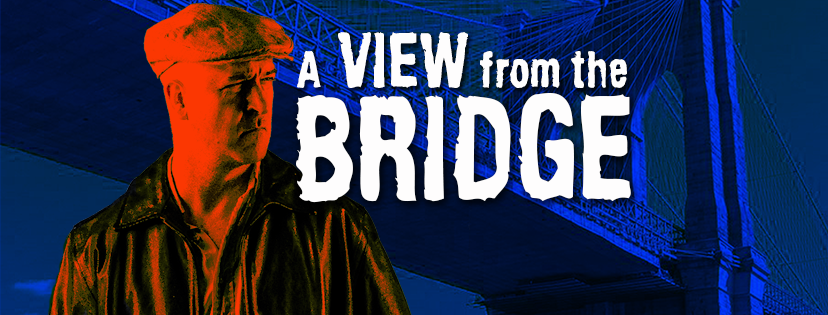Most people ain’t people. Because people strive to treat each other with dignity and respect. Of course, that was the point Arthur Miller might have been trying to make when he scribbled down A View From the Bridge. Horrifically relevant and strikingly topical in today’s political climate, this intense family-driven drama is an exacting fit for the style of ensemble performance work which the Maryland Ensemble Theatre prides themselves on and does exceedingly well. Their current production of A View From the Bridge, which closes out their 2017/2018 season, is no exception as it is an extraordinarily brilliant and strikingly honed piece of theatre. Directed by Gerard Stropnicky, this evocative and poignant drama hits close to home and hits hard considering the current political stances on border patrol and immigration to this fine dreamer’s country we call America.
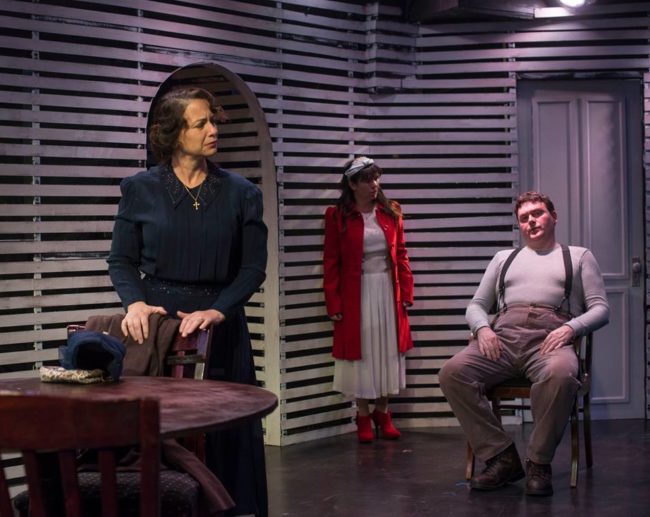
Appearing at first ordinary, the duality of Scenic Designer Cody Gilliam’s set is impressive. Wooden crate-slats, not unlike shipping pallets to be unloaded from the docks, create the walls and serve as a blank canvas for projections that assist in the production’s scenic transitions. Lighting Designer Diane Baas and Sound Designer Jerry Matheny work in tandem with Director Gerard Stropnicky to bring the audience directly into the world of Eddie Carbone and his family circa 1947. The persistent wail of the ship’s horn juxtaposed against projections and video imagery of workers on the docks and the Red Hook section of Brooklyn from that era create a breathtaking scenescape which burbles the transitions from scene to scene along sublimely. The overwhelming rush of these images and sounds often flood over the stage, immersing and almost drowning the audience in the reality that the characters are about to experience.
Stropnicky’s approach to fully integrating the ensemble nature of the piece creates a glorious theatrical experience. The minimalist scenery which is shuffled on and off the stage is done by the supporting ensemble, all dressed like dock workers. Costume Designer Stephanie Hyder creates clever disguises in this fashion, transforming Immigration Officers and other characters into the faceless masses of the working culture of 1947 Brooklyn, New York. Hyder should also be commended for the distressed appearance of the costumes featured throughout the house of Eddie Carbone, be the costumes on natives or immigrants. Hyder’s finest achievement is the adorable period appropriate se dresses that parallel Catherine’s burgeoning womanhood to her naiveté.
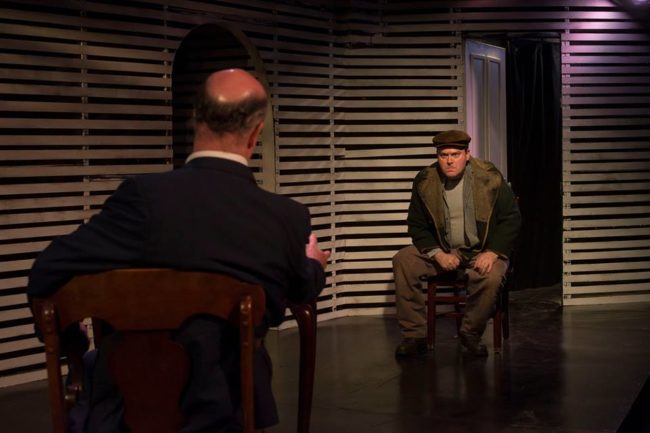
There is a mysticism the way that Stropnicky plays with the intimate staging space throughout the production. Alfieri, the show’s narrative construct, often appears to drift into and out of scenes like a narrative apparition, augmented in blue light (again, Baas’ ingenious approach to illumination) to signify that memory has occurred or is in fact occurring in present recollection. Drawing the audience into the tale is something Stropnicky hones in on at the beginning and follows this notion through to the end. One of the more impressive elements of this, is his perspective on point of view. Alfieri is a unique character as he is essentially outside of narrative in memory, except for the two scenes where he actively participates as a character. Stropnicky initially sets Alfieri’s office facing in one direction and then in the opposite when it is revisited, to give the full experience of both sides of the coin in this terse and edgy situation.
Performances across the ensemble are wondrous. None quite so impressive as the aforementioned narrative source, Alfieri (Tad Janes.) With a commanding grip on that Brooklyn streets accent, Janes is superior in his narrative approach to the show. In addition to carefully cultivating these moment of memory, Janes’ in-scene moments as Alfieri are riveting. At the end of his second encounter with Eddie Carbone inside his office, Janes delivers a last desperate cry of hope, shouting off to the gallows as Eddie exits. This is truly a harrowing scene, and puts the chills straight through the spine as the desperation in Janes’ voice echoes throughout the mind from that moment until the show’s conclusion.
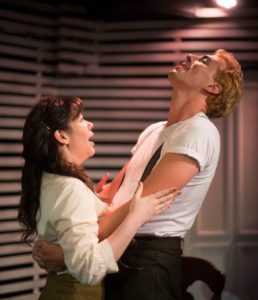
Karli Cole takes up the role of Catherine and exemplifies what it is to be a wispy waif of a thing, steeped in a balanced blend of bubbly naiveté and burgeoning womanhood. Giddy and exuberant, yet fettered by her own ignorance, Cole’s Catherine is fascinating to observe. Watch carefully the dynamic she explores between her character and Eddie Carbone as well as the Rodolpho character. There is a slightly unsettling nature to the way Cole allows Catherine to behave when in the presence of Eddie, though this only further heightens the tensions that erupt throughout the drama as it unravels. The chemistry, coy and innocent at first, which burbles between Cole and the strapping young immigrant is thrilling; it serves as a driving force to raise the stakes, heighten the tension, and ultimate propel the show’s natural tragic trajectory forward.
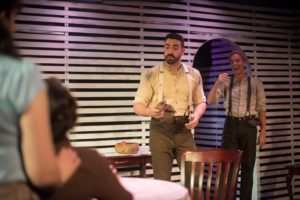
Rodolpho (Jeremy Myers) and brother Marco (Clay Comer) are as easy on the eyes as they are vexing in the mind in regards to their dynamism. Comer, whose character is bold but reverent, is of a fiery, albeit playful, spirit, especially in the first half of the performance. When going at it opposite of Myers, the pair share a fraternal comradery that is most congenial. Comer’s explosive rage comes much later in the production but is well worth the wait to experience such a phenomenon. Myers, playing the more charismatic and freely spirited Rodolpho, is humorous and kind, creating a loveable, albeit flawed, human being out of the younger of the two Italian brothers. Both comer and Myers share a natural knack for slightly exaggerating the Italian-immigrant accent and both create high points of tension when the scene calls for it.
While women of that time were not meant to have all of the feisty spirit and opinionated expression of the modern day woman, Jeanine Evans manages to imbue all of that into Beatrice and still allow the character to fit into the period. Evans’ portrayal of Beatrice is gritty but in a familiar and grounded fashion. Perfecting the art of Beatrice’s passive-aggressive silences, Evans drives nail after nail of dramatic tension into the arguments and confrontations with Eddie Carbone, laying down a line of hot, explosive fire, when it comes to certain accusations, which evolve as the play unravels.
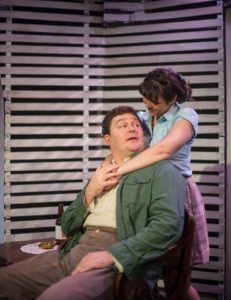
Eddie Carbone (Jack Evans) is the man who don’t seem to properly understand that blood is thicker than water. Jack Evans gives a spectacular performance in the role, a truly stunning, at times jaw-dropping creation of this calloused, hardened, troubled man, twisted and warped with frustrations of an inevitable prejudice that he cannot rise above. Evans’ Eddie festers with an all-too-real prejudice that despite the passage of time is still potent and present in people of this country today; Evans makes that revolting insecurity and heinous prejudice so pungently palpable that it’s nauseating. The full-blown, rage-informed meltdown which spirals Evans’ character out of control is both terrifying and exhilarating to watch. There is a constant percolation of tension between Evans’ Eddie and Myers’ Rodolpho, and when it comes to an unexpected head, there’s a conflagration of mind-blowing sparks and powder keg eruptions that are simply astonishing.
It is frightening to think that the struggles from 70 years in the past could be so relevant to our country’s current situation. The Maryland Ensemble Theatre’s production of A View From The Bridge captures the essence of that notion to perfect, showing us the ugly undertones that still charge the masses of our country today.
Running Time: 2 hours and 30 minutes with one intermission
A View From The Bridge plays through June 17, 2018 on the Main Stage of the Maryland Ensemble Theatre in the Historic FSK Hotel building— 31 W. Patrick street in downtown historic Frederick, MD. For tickets call the box office at (301) 694-4744 or purchase them online.

